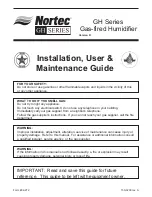
8
warm water also leaves fewer solids on the surfaces of the pad and flushes
contaminants out of the pad. Excess water is collected in the bottom trough and exits
through the drain.
To avoid build-up of mineral deposits on the pad and potentially causing blockage of the
air flow, it is recommended that hard water be treated (filtered and softened). Install a 5-
or 10- micron in-line water filter ahead of the humidifier to keep dirt from fouling the inlet
screen and the evaporation pad inside. If the water has a high mineral content, a
softener may be needed to prevent excessive scale from building up too rapidly on the
pad.
Additionally, to insure adequate wetted surfaces and to help flush away excess
minerals, the water flow is set to always have a flow of water to the drain. When
operating, the humidifier will use approximately 1 to 2 gallons (4 to 8 liters) of water per
hour depending on the water pressure in the building. About 60% of that will pass
through and go out the drain. There is a strainer and an orifice in the line to restrict the
flow of water, but a throttling valve may be needed to keep too much water from going
to the pad. All that is needed is a steady dripping of water out of the drain to ensure
adequate wetting and flushing of the pad media. Excess water does not negatively
impact the humidifier’s operation but neither does it contribute to more humidification.
The drain volume is too much for just a bucket. A gravity drain line should be piped to
an open floor or sink drain, or a condensate pump may be used where a gravity drain is
impractical. This excess drain water can be discharged directly onto the ground. The
discharge of the drain can be combined into the condensate drain from the cooling unit.
The humidistat, located in the cellar, will automatically turn on the humidifier whenever
the cellar humidity is below the set point and turns it off when the cellar humidity
reaches set point. The recommended setpoint is 55% RH for wine cellars. This humidity
level is high enough to prevent corks from drying out and low enough to prevent mold
from forming. When the humidifier turns on, the water solenoid valve opens, and the fan
turns on. When mounted and connected to a Wine Guardian cooling unit, the humidistat
also controls the main fan to circulate air to and from the cellar.
CAREFULLY FOLLOW THE INSTALLATION INSTRUCTIONS INCLUDED WITH THE
HUMIDIFIER. REFER TO THE MANUFACTURER’S INSTRUCTIONS CONTAINED IN
THE BOX FOR THE HUMIDISTAT. WE RECOMMEND YOU KEEP THESE
INSTRUCTIONS IN A FOLDER ALONG WITH THIS GUIDE FOR FUTURE
REFERENCE.
Size and Capacity
The Wine Guardian Humidifier uses a
10” wide x 10” high x 1.5” thick (254mm wide x
254mm high x 38mm thick) expanded coated aluminum pad. Its rated output capacity
for wine cellars is 1.11 lbs/HR (0.5 kg/HR) using 100°F (38°C) supply water. Humidifier
capacity is rated at wine cellars conditions of 57°F/55% (14°C).
Summary of Contents for 99H0173-20
Page 9: ...9 Wiring Diagram Integrated Humidifier 60Hz 50Hz...
Page 10: ...10 Wiring Diagram Freestanding Humidifier 60Hz...
Page 11: ...11 Wiring Diagram Freestanding Humidifier 50Hz...
Page 12: ...12 Humidifier Dimensions Freestanding...
Page 13: ...13 Humidifier Dimensions Integrated...
Page 16: ...16 Fig 1 Fig 2 Fig 3 Fig 4 Fig 5 Fig 6 Fig 7 Fig 8...
Page 19: ...19 Fig 11...
Page 21: ...21 Fig 12 Fig 13...
Page 22: ...22 Fig 14 Fig 15...
Page 24: ...24...









































